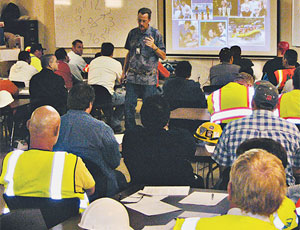...about the fatalities too often or too loudly on the job. And there already has been enough bad luck at City- Center. So the issues and circumstances surrounding the six deaths are never exactly addressed. No one brings up how or why operating engineer Harvey Englander, 65, was hit by a man-lift counterweight or what the circumstances were when ironworker Harold “Rusty” Billingsley, 46, fell through an opening in floor decking.

I have another reason to be concerned about construction safety: I know the physical and emotional wreckage that can result from one lapse. My 44-year-old brother-in-law, Darin, who is a sheet-metal worker, was working on another job on the Las Vegas Strip a year ago when he was nearly killed in an 18-ft fall. A sweet and likable man, a perfect football and beer buddy, Darin had always taken great care of himself, eating right and getting to bed early in order to do his job well and make it home okay. The day of his accident, he was on a scissor-lift installing overhead ductwork and leaning against a cage bar when it unexpectedly gave way. Only Darin’s angle of impact and his beefy 220-lb frame saved his life.
Falling is a lot like being hit by a car, only you are the one that is moving. Darin shattered his left-eye socket, broke his nose, dislocated his right shoulder, snapped his right femur and cracked two ribs. The impact left him black and blue with contusions and cuts.
We found ourselves in the hospital waiting room wondering if he would live. The day of his accident, there was no comforting Darin’s sister or mother, both sick with grief and worry. A storm of emotions swirled inside my head: Would Darin be permanently crippled? Wheelchair bound? Hours passed, scraping our nerves raw.
Doctors said he was lucky. Over the next few days and weeks, plastic surgeons twice reconstructed Darin’s face. After eight months of intense, painful physical therapy, Darin is walking and working again. There’s a metal rod in his leg and a twinge in his shoulder that will never go away. Yet things could be worse. Darin once again is knocking tin, this time at CityCenter.
The employers at CityCenter, starting with Perini, are supposed to have turned a corner now that everyone goes through the Occupation Safety and Health Administration’s (OSHA) 10-hour training. Perini says it was prepared to provide the training even before the brief strike and picketing erupted at the project on June 3, 2008. “We did not bat an eye at the idea,” claims W. Shelton Grantham, Perini’s vice president of field operations. “It is a proactive way to make sure everyone goes home at night.”
On the surface, both Perini and building trade unions now appear happy. The contractor has since upped its safety staff to 34 people, and its subcontractors must have at least one safety professional for every 40 employees. All new hires since the agreement are required to provide an OSHA 10 card or undergo mandatory on-site training. Only 15% of CityCenter’s workforce had gone through training at the time of my visit in October. New hires are immediately processed. But with a peak total workforce of 9,200, it is much harder to find and train existing employees since many are from out of state and were working on the site before the union pact. Perini has additionally hired 14 trainers and created seven classrooms to get everyone up to speed. Unions help train their members with assistance from the union-funded Center to Protect Workers’ Rights. Altogether, employers and unions have trained 10,000 workers in less than six months. That number includes workers at the adjacent $4-billion Cosmopolitan resort project where Perini also is general contractor. Perini’s goal is to train all of the approximately 11,000 workers currently employed at both projects by midyear. The numbers are large, like everything at CityCenter.
Squawking
Subcontractors, which number in the hundreds, must pay for their own staff training. The cost? $500 per worker. That has many subs squawking over the expense and lost productivity. The overall cost for OSHA 10 safety training will be about $5 million, Perini says. No one has been killed since the training push started.
But there may be less improvement when it comes to lost-time injuries. One safety official, who asked to remain anonymous, said the training has not made a noticeable difference. At the time of my visit, lost-work-time numbers posted inside the job’s offices seem to confirm as much. The Mandarin Oriental condo-hotel tower, a part of CityCenter, had only gone three days without a recordable accident.
In fairness, it is important to keep numbers in perspective. The project had recorded a staggering 24 million hours of work at the time of my visit; that week’s daily payroll was $3.125 million. The project’s injury rate, when examined in context, rises only slightly above the state average. Yet the effectiveness of the training push remained unclear at the time of my visit.
Fatigue is one of the worst hazards on the job. Surprisingly, little or no mention is made of it on the job, except to...


Post a comment to this article
Report Abusive Comment